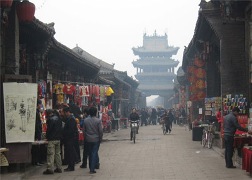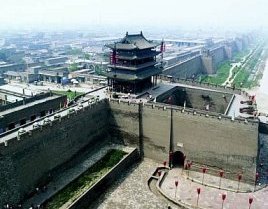The past is alive in Pingyao. Whereas other cities have embraced modernity often at the expense of their historical heritage, Pingyao tenaciously holds onto its past.
As dawn breaks and the morning sun bathes Pingyao's gray city walls in warm tones, you find yourself flung back in time, as your eyes behold a Ming dynasty fortress in all its imposing glory. Watchtowers, cast iron cannons, intimidating wooden gates and sturdy walls render an impenetrable feel. And then the city wakes up. Narrow alleys that coil around time-honored courtyard homes fill up with its 480,000 denizens. Shops open their doors to reveal modern cashier equipment perched on antique tabletops. Bustling about are bicycles, rickshaws and scooters. Here in Pingyao, modernity lives with centuries old relics.
The old walled city is an architectural treasure trove. Civic buildings, private homes and streets are well preserved in Ming and Qing styles. Few buildings rise above two stories. Several are adorned with splendid eave roofs, intricately latticed windows, hand-painted glass lanterns and ornate wood.
Such exquisite handiwork didn't come cheap, but then again, Pingyao was China's premier banking center during the two dynasties. Its wealthy residents were comprised of merchants and businessmen who set about constructing sprawling mansions as expertly as they built up their business and trade. Of the many banks in Pingyao, Rishengchang Exchange Shop is the most famous. Originally established in 1643, it still has records of its earliest days in business.
One reason for the city's prosperity was its location. It lay at the heart of Shanxi Province between the central plain and the northern desert. Han Chinese merchants occupying the central plains could communicate easily with the northern tribes and set up trade links with the rest of China.
The stoic city walls also did its part to shield Pingyao from marauding enemies from the 14th to 19th centuries, allowing the city to flourish swiftly. The walls were first erected in the Zhou dynasty and last rebuilt during the Ming. After the Song army set the earthen walls on fire in 960, the walls were covered with bricks.
The fortifications are sophisticated - the square perimeter is 12mhigh and 5m thick and there are platforms every 50m with 3,000 crenels on the outer wall, 72 watchtowers, and a water drainage system reinforced with bricks at the top. The wall is surrounded by moats 3m wide and deep and six suspension bridges once fronted each city gate. You can walk all the way around the walls in 2 hours.
By the 19th century, the once dynamic town fell into provincial obscurity and the walls became a psychological prison. When modernization fever swept through China in the 1980's, town officials laid plans to demolish the ancient city and rebuild the town to accommodate what was hoped to be a future economic boom.
As the city planners dreamt of a modernized city and Pingyao's economic revival, people on the ground struggled to rescue the ancient city. Professor Ruan Yisan, who specialized in urban planning at Tongji University in Shanghai, worked tirelessly to make officials aware of the cultural value of Pingyao. His efforts paid off, and modernization was left outside the ancient wall. In 1986, Pingyao was declared a national historical city and protected it from demolishing. The town was flushed with funds, accelerating its conservation efforts. In 1997, Pingyao made it to the list of UNESCO's World Heritage Sites, thus a silver lining finally revealed itself.
Memorable Experiences
Watching the city folk play card games and hangout at the Temple of the City God gates.
Sampling the street snacks: sugarcane, nuts, candied and dried fruit.
Enjoying tea with the locals, who spend lazy afternoons in the street-side teahouses.
Listening to the sounds of the city below while perched atop the Town Tower.
Observing the how millet wine is made at a wine shop called Changsheng yuan, next to the Town Tower. |
